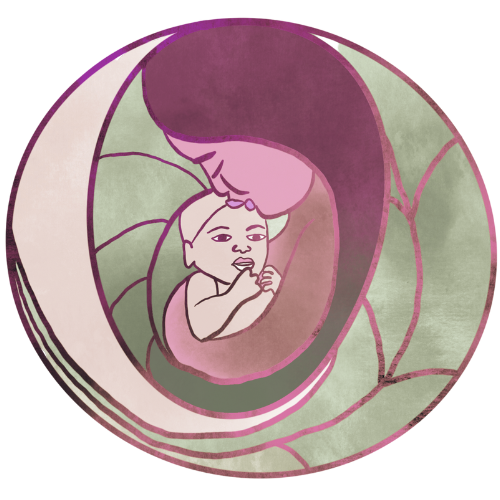Maryland Midwife Licensing: What You Need to Know (LDM, CPM, CM, CNM)
Intro to All You Need to Know
If you’ve ever browsed midwife websites or met with a few potential care providers, you’ve probably noticed a handful of mysterious letters following their names—CNM, CM, CPM, LDM. They sound official (and they are), but if you’re new to midwifery, they might feel like alphabet soup. The truth is, those credentials can make a big difference in your birth options here in Maryland.
The type of license or certification your midwife holds determines not only where they can legally attend your birth—home, birth center, or hospital—but also what kind of training they’ve had, whether insurance might cover their services, and what safety protocols they’re required to follow.
Maryland has its own set of laws and requirements around midwifery, and they’re not exactly the same as other states. So whether you’re leaning toward a cozy home birth or the supportive environment of a birth center, it’s worth understanding the letters behind your midwife’s name before you make your choice.
In this guide, we’ll break down the four main credentials you’ll see in Maryland, how they affect your birth options, and what to consider when choosing your care provider.
Why Midwife Licensing Matters
In Maryland, midwifery is regulated to ensure that anyone attending a birth has met specific training, safety, and ethical standards. This isn’t just red tape—it’s about protecting both you and your baby. Licensing creates accountability. It means your midwife has been vetted, their skills have been assessed, and they’re required to follow certain legal guidelines.
The type of license a midwife holds determines:
Where they can practice: Some midwives can attend hospital births, some only work out of hospitals, others specialize in out-of-hospital births like home or birth center deliveries.
What they can offer: Certain credentials allow for a wider range of medications, interventions, or specific birth services.
Insurance coverage: If you’re hoping to use insurance, you’ll need to know which credentials your plan covers in Maryland.
Transfer protocols: Midwives are trained to recognize when a transfer to a hospital is the safest choice, but credential type may shape how that process works.
Choosing a midwife is about more than personality fit—it’s also about making sure their credentials match your birth goals. For a closer look at common misconceptions around midwifery, see our post Midwifery Myths Debunked.
The Four Main Midwife Credentials in Maryland
Certified Nurse Midwife (CNM)
A CNM is both a registered nurse and a trained midwife. They’ve completed a graduate-level midwifery program and passed a national certification exam. Because of their dual background, CNMs can practice in a wide range of settings—hospitals, birth centers, and (in some cases) at home.
In Maryland:
CNMs are licensed by the Maryland Board of Nursing.
They can prescribe medications, order labs, and offer a broader range of interventions.
They’re the most likely to be covered by insurance for both in- and out-of-hospital births.
For families who want the option of hospital-based care while still benefiting from midwifery’s low-intervention approach, a CNM can be a great fit.
Certified Midwife (CM)
A CM has the same midwifery training as a CNM but without the nursing background. They also complete a graduate-level program and pass the same national midwifery exam, but they enter the field from non-nursing backgrounds.
In Maryland:
CMs are less common, but they are licensed to practice.
They can often attend births in birth centers and some home settings, depending on arrangements and state rules.
Insurance coverage varies more than with CNMs.
Certified Professional Midwife (CPM)
A CPM is trained specifically in out-of-hospital birth. They may have completed a midwifery school program or an apprenticeship-based pathway, but all CPMs must pass a certification process through the North American Registry of Midwives.
In Maryland:
CPMs are recognized through a state-specific license called the Licensed Direct Entry Midwife (LDM).
They specialize in home and freestanding birth center deliveries.
Their training emphasizes physiologic birth, normal variations, and home birth safety protocols.
Licensed Direct Entry Midwife (LDM)
In Maryland, the LDM is the legal title for a CPM who meets the state’s licensing requirements. This includes proof of education, clinical experience, and passage of the national CPM exam.
In Maryland:
LDMs are regulated by the Maryland Office of Health Care Quality.
They can legally attend planned home births for low-risk pregnancies.
There are specific rules about which clients they can accept (for example, some VBACs may require additional conditions).
For more details, see the Maryland Office of Health Care Quality – Licensed Midwives.
Where Each Type of Midwife Can Practice in Maryland
Not every midwife can work in every setting. Here’s the short version:
Hospital births: Typically CNMs and some CMs.
Birth center births: CNMs, CMs, and some LDMs depending on the facility.
Home births: LDMs (licensed CPMs) and some CNMs.
Maryland also has specific rules around VBAC (vaginal birth after cesarean) for out-of-hospital births, so if that’s part of your plan, you’ll want to discuss it upfront.
The Midwives Alliance of North America – State-by-State Legal Status is a helpful resource for seeing how Maryland’s rules compare to other states.
And if you want tips for getting through early labor at home, read our post Laboring at Home Before the Midwife Arrives.
How to Choose the Right Midwife for Your Birth
Once you understand the credentials, it’s time to match them to your vision for birth. Ask yourself:
Where do I want to give birth?
What level of medical intervention am I comfortable with?
Do I need someone who can prescribe medications or order ultrasounds directly?
How important is insurance coverage to me?
When interviewing potential midwives, ask about:
Their training and years of experience.
How many births they’ve attended in your preferred setting.
Their approach to common scenarios (like a long labor or a stalled dilation).
Transfer protocols and relationships with local hospitals.
For help clarifying your vision, see our guide Creating a Birth Plan: Embrace Your Inner Wisdom.
Insurance and Cost Considerations by Credential
Insurance coverage in Maryland varies widely.
CNMs: Most likely to be covered for both in-hospital and out-of-hospital births.
CMs: Coverage varies—check with your provider.
LDMs/CPMs: Often out-of-network; some families submit for partial reimbursement.
It’s worth calling your insurance company before making a final decision. Ask them:
Is this credential covered for the type of birth I’m planning?
Is the midwife considered in-network?
If out-of-network, what’s the reimbursement rate?
For a deeper dive, check the National Women’s Health Network – Midwifery and Insurance.
Final Thoughts
Understanding midwife credentials in Maryland isn’t just about memorizing acronyms—it’s about making sure you have the right support in the right setting. Your choice will influence your birth location, your insurance coverage, and the tools and training your midwife can bring to your care.
Whether you feel most comfortable in your own home, at a freestanding birth center, or in a hospital with midwifery care, knowing these differences will help you choose confidently.
If you’re ready to explore your options, contact us today.
FAQs
1. What’s the difference between a CPM and an LDM in Maryland?
A CPM is a Certified Professional Midwife—a national certification for midwives trained in out-of-hospital birth. An LDM is a CPM who has met Maryland’s state-specific licensing requirements to practice legally in the state.
2. Can a CNM attend a home birth in Maryland?
Yes, if they have the proper training, licensing, and willingness to do so. Not all CNMs offer home birth services, so you’ll need to ask directly.
3. Are CMs licensed in Maryland?
Yes, but they are less common. CMs have the same midwifery training as CNMs without a nursing degree and can practice in certain birth settings.
4. Which midwife credential is best for high-risk pregnancies?
High-risk pregnancies are usually managed by CNMs in collaboration with physicians in a hospital setting. Out-of-hospital midwives typically work only with low-risk clients.
5. Will insurance cover my midwife’s services?
It depends on your plan, your midwife’s credential, and your birth setting. CNMs have the highest likelihood of being covered in-network, while LDMs and CPMs are often out-of-network.

